Märkisches Museum
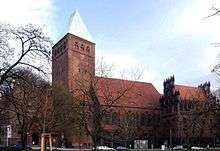
The Märkisches Museum (Marcher Museum; originally Märkisches Provinzial-Museum, i.e. Museum of the Province of the March [of Brandenburg]) is a museum in Mitte, Berlin. Founded in 1874 as the museum of the city of Berlin and its political region, the March of Brandenburg, it occupies a building on the northern edge of Köllnischer Park, facing the Spree, which was designed by Ludwig Hoffmann and completed in 1908. It is now the main facility of the Stiftung Stadtmuseum Berlin, Landesmuseum für Kultur und Geschichte Berlins, the City of Berlin museum foundation, which also operates four other sites.
Background
In the second half of the 19th century, Berlin grew very rapidly. The foundation stone of a new, much larger town hall, the Rotes Rathaus, was laid in 1861. The changes provoked interest amongst the bourgeoisie in the city's past and in preserving what had not already been lost. The Verein für die Geschichte Berlins (Association for the history of Berlin) was founded. It included early photographers such as Friedrich Albert Schwartz[1] who began to document the changes to the city, assembling one of the first systematic photographic portraits of a city and its architecture. Beginning in the 1860s, they urged the foundation of a regional history museum. Ernst Friedel, a judge and antiquarian who had personally collected prehistoric and historic objects and paintings from Brandenburg for this purpose, persuaded the Magistrat, the executive council of Berlin, to form a new department of "Collections" and Friedel was appointed to head it together with the existing library and archive. On 9 October 1874 with the city's official acceptance of his plan, the Märkisches Provinzialmuseum (Provincial museum of the March) was founded.[2][3] This was the first museum in Berlin to be completely independent of the Prussian crown.[4] It had a budget of only 2,000 Goldmarks a year for purchases, and was therefore dependent from the start on donations from foundations and individuals.[5] The Emperor later contributed a small fund for the purchase of photographs of the city.
Early history
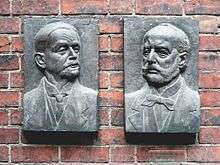
In March 1875, Friedel put out a call for the donation or loan of objects of historical or scientific interest, which was so successful that the collection had to move late that year from the old town hall to the Palais Podewils, a Baroque residence in Klosterstraße, and in 1880 to the former town hall of Cölln. At that time it had over 29,500 objects.[6] In addition, Berlin in the "Gründerzeit" was full of demolitions and excavations, which yielded both fragments of old buildings and prehistoric and medieval finds.[7] The collection was crowded and in particular the large pieces taken from churches could not be properly displayed.[8] However, the inventory was not without its uses: an axe from the collection was used on 16 August 1878 to execute Max Hödel after his attempted assassination of Emperor Wilhelm I.[9]
At the urging of Friedel, a competition was held in 1892 for a building to house the collection, but the results were disappointing. 76 entries were received, but the winning design, by Wilhelm Möller, proved on examination to be both unsuitable and too expensive, and the architect had died,[3][10][11] so the project was shelved.[12][13]
Building


Creating a new building for the museum was the first large task for Ludwig Hoffmann after his appointment in 1896 as Stadtbaurat (chief of construction) for the city of Berlin. His first sketches date to that year; the plans were accepted the following year, and construction began in 1899 and was completed in 1907.[13] It was not ready for occupation until 1908,[14] 12 years after the start of the project. Meanwhile, in 1899, in advance of the demolition of the Cölln town hall, some of the collection had been placed in storage and some shown in temporary quarters on the first floor of one of the city's covered markets, until 1904.[3][13]
Hoffmann designed the museum as a complex of six differing buildings which echo Brandenburg brick architecture of periods from the Gothic to the Renaissance in a "historical collage", in order to reflect the contents of the museum and evoke the "atmosphere" of various times and types of building.[12][15] Part of his reasoning was that Berlin no longer had much of an old centre.[16] The buildings are grouped around two courtyards and based on historic details which he had studied and sketched throughout the region; his "quotations" are accurate copies, but there is disagreement as to the originals, as in a façade which has been said to be based on the town hall at Tangermünde[12] or on St. Catherine's Church in Brandenburg an der Havel,[17] and the hip-roofed tower, 53 metres (174 ft) high,[3] based on the bergfried (keep) of the Bishop's Castle in Wittstock[17] or on the cathedral of Ratzeburg.[18] Hoffmann also modified the layout of Köllnischer Park to make an attractive setting for the museum.[19]
The interior of the museum also seeks to evoke the atmosphere of different historical settings (as was then the fashion in provincial museums in Germany).[12] For example, the low vaulted ceilings and roughly plastered walls on the ground floor were intended to suggest great age and housed the displays on prehistory, where the display cases for funerary urns and flint axes were rough in form; the setting for the medieval altars and sculptures was a vaulted Gothic chapel echoing medieval church interiors;[18] weapons were shown in a room with thick columns, recalling a monastery;[12] and rococo porcelain and snuffboxes were displayed in elegant vitrines in a light and airy room on the second floor. There were a total of about 50 exhibition galleries. The visitor was led repeatedly back to the central vaulted Great Hall.[20]
A week before the opening on 10 June 1908, Emperor Wilhelm II and Empress Auguste Viktoria toured the exhibits for two hours.[17][21] The museum is now judged to be amongst Hoffmann's most important works, and also one of the most outstanding German museum buildings.[22][23]
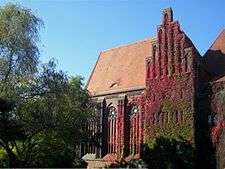

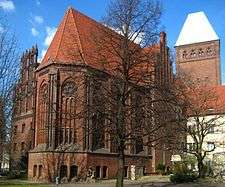
History since 1908
Before and after World War I
The museum was widely praised and popular, attracting approximately 70,000 visitors a year and supported by the Verein für das Märkische Museum, which included some wealthy and prominent Berliners. Especially after the creation of Greater Berlin in 1920, it focussed more on the city than on the Mark Brandenburg.[3][24] However, it was affected by the First World War and the revolution and out of control inflation which followed it.
In 1925, Walter Stengel became Director of the museum, the first in that position with professional training and experience in art history and museum science. He left Hoffmann's gallery displays largely untouched, but did introduce electric lighting in 1932, over the objections of the now retired architect.[3] He also experimented with recorded commentary in the galleries, using gramophones.[25] He used the museum extension, the 18th-century Ermeler House, to display the Alfred Cassirer collection of artworks, including several works of French Impressionism, as a unified whole,[26] and to draw visitors back to the museum, held spectacular special exhibitions, some of them offsite. The exhibition celebrating the 70th birthday of the popular illustrator Heinrich Zille in 1928, the first extensive exhibition of his work,[27] was especially popular.[28]
Under the Third Reich
After Hitler's seizure of power in 1933, the Märkisches Museum was like other cultural facilities in Germany incorporated into the Nazi system. Stengel collaborated with the Nazis, in the interest of the museum as he saw it, acquiring art objects from Jews in forced sales and securing valuable antiques in 1938 when the regime seized all gold and silver items from Jews.[29][30] After the war, he stated that these items were held in escrow and not simply merged into the museum's holdings.[29]
The museum remained popular until the outbreak of the Second World War in 1939, when it was closed and its collection placed in storage.[23] Much was lost,[31] and the building itself was severely damaged.
Under Soviet occupation and in the German Democratic Republic
When the war ended, the museum was located in the Soviet sector of Berlin which became the capital of the German Democratic Republic (East Germany). The first few galleries were reopened in 1946. Some items were rescued from buildings destroyed in the war, but the need for repairs to the building restricted available space and most of the natural history collection had been lost, so the decision was made to focus on cultural history. In a restoration which took place from 1953 to 1958,[12] the interior was subdivided by partitions and lowered ceilings,[20] increasingly destroying Hoffmann's gallery scheme, and museum staff were required to present history on a Marxist-Leninist basis.
After the Berlin Wall divided the city in 1961, the decision was eventually made to establish a separate Berlin Museum in West Berlin. Founded in 1962, this was housed in the baroque Collegienhaus of the former Kammergericht in the Lindenstraße in Kreuzberg,[3] and the collection was limited to cultural history so that the two museums could be eventually reunited with as few problems as possible.
Since reunification
After German reunification, five years of discussion and planning culminated in the foundation in 1995 of the Stiftung Stadtmuseum Berlin, Landesmuseum für Kultur und Geschichte Berlins, which now unites several formerly independent museums under the City of Berlin, with the Märkisches Museum as primary location.[21] The building itself was extensively renovated in 1996–2001,[12] including building out of new space under roofs and the removal of added partitions so that visitors again experience the sequence of galleries much as Hoffmann intended,[18][20] but a large part of the museum's holdings is in storage in Spandau for want of space.[17] The Senate of Berlin plans to unify currently scattered holdings in Mitte, in and around the Märkisches Museum, and has thus projected an extension to the building, which is to incorporate the nearby Marinehaus, designed by Otto Liesheim and built in 1908–10.[32] The existing museum is to house the coverage from prehistory to the start of the 20th century, and the extension, recent history.[18] The Senate acquired that building in 1993, and the architectural competition to design the extension and conversion was won by the London firm of Stanton Williams in 2008.[33][34]
The Stiftung Stadtmuseum Berlin originally had 16 locations.[35] Under the consolidation plan, the Stiftung Stadtmuseum Berlin found other owners for the Nicolaihaus,[36] the Domäne Dahlem, an open-air museum of agriculture on the original estate at Dahlem,[37] and the Sport Museum in the Sportforum near the Olympic Stadium,[35] and closed the Museum of Hairdressing in Marzahn,[35] the Sammlung Kindheit und Jugend (children's museum),[38] the Natural History collection[39] and its former administrative offices, and relocated them to the Märkisches Museum. As of February 2011 the childhood section in the Märkisches Museum was showing an exhibition of model shops.[40] Closure of the Galgenhaus[41] is also planned. The Marinehaus is to be used for especially popular displays on the history of Berlin in the 20th century while the original building undergoes thorough restoration, and the foundation continues to operate museums in the 18th-century Knoblauchhaus,[42] the rococo Ephraim Palais,[43] and St. Nicholas' Church,[44] all in the nearby Nikolaiviertel. It also has a museum village in the Zehlendorf district, the Museumsdorf Düppel, which is a recreation of a medieval village.[32][45]
Friedrichsfelde Palace, Friedrichsfelde, formerly also part of the foundation, was returned in January 2009 to Tierpark Berlin, the zoo in its former grounds.[46][47] The Jewish Museum grew out of the West Berlin Berlin Museum, but in 1998 was declared autonomous and in 2001 became a federal institution, and as such is independent of the Stiftung Stadtmuseum Berlin.[48][49]
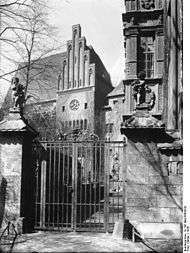


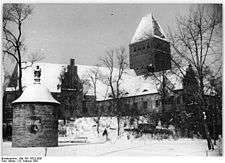
References
- ↑ Das Landesarchiv Berlin und seine Bestände volume 4 Übersicht der Nachlässe (Tektonik-Gruppe E) und Sammlungen (Tektonik-Gruppe F), Schriftenreihe des Landesarchivs Berlin, 3rd ed. rev. Heike Schroll and Regina Rousavy, Berlin: Berliner Wissenschafts-Verlag, 2006, ISBN 9783830511458, p. 199 (German)
- ↑ Gustav Albrecht, "Ernst Friedel, 1837 – 1907: Ein Gedenkblatt zum 70. Geburtstage", Festschrift zur Feier des siebzigsten Geburtstages ihres Ersten Vorsitzenden, des Geheimen Regierungsrates und Stadtrates Ernst Friedel, Archiv der Brandenburgia, Gesellschaft für Heimatkunde der Provinz Brandenburg 12 (1907) OCLC 174693267, pp. 1–64, pp. 30, 31 (German)
- 1 2 3 4 5 6 7 Michael S. Cullen, "Das Gedächtnishaus der Urenkel", in: Der Tagesspiegel, 14 October 1998 (German)
- ↑ Kurt Winkler, "'Alt-Berlin' im Märkischen Museum. Musealisierung als Strategie der Modernisierung", in: Roland Berbig et al. (eds.), Berlins 19. Jahrhundert: Ein Metropolen-Kompendium, Berlin: Akademie, 2011, ISBN 978-3-05005083-6, pp. 491–506, p. 496 (German)
- ↑ Kai Michel, "'Und nun kommen Sie auch gleich noch mit 'ner Urne. Oder ist es bloss 'ne Terrine?' Das Märkische Provinzial-Museum in Berlin (1874–1908)", in Mäzenatisches Handeln: Studien zur Kultur des Bürgersinns in der Gesellschaft: Festschrift für Günter Braun zum 70. Geburtstag, ed. Thomas W. Gaehtgens and Martin Schieder, Bürgerlichkeit, Wertewandel, Mäzenatentum 1, Berlin: Fannei & Walz, 1998, pp. 60–81, p. 79 (German)
- ↑ Albrecht, pp. 32–33.
- ↑ Winkler, "Alt-Berlin", p. 497.
- ↑ Sven Kuhrau, Der Kunstsammler im Kaiserreich: Kunst und Repräsentation in der Berliner Privatsammlerkultur, Doctoral dissertation, Free University of Berlin, Kiel: Ludwig, 2005, ISBN 9783937719207, p. 195 (German)
- ↑ "Scharfe Sache", Stadtlichter, Der Tagesspiegel, 15 April 2008 (German)
- ↑ C. Jk., "Zur Erinnerung an Wilhelm Möller", Deutsche Bauzeitung 26 (1892) p. 337 (German)
- ↑ K., "W. Moeller †", Centralblatt der Bauverwaltung 28 (1893) p. 288 (German)
- 1 2 3 4 5 6 7 Märkisches Museum, Denkmale in Berlin, Senatsverwaltung für Stadtentwicklung und Umwelt (German)
- 1 2 3 Albrecht, p. 33 (German)
- ↑ Albrecht, p. 34.
- ↑ Ludwig Hoffmann and Fritz Stahl, Ludwig Hoffmann, Berliner Architekturwelt Sonderhefte 14, Berlin: Wasmuth, 1914, OCLC 4320395, pp. xi–xv (German); images and drawings, pp. 1–23; pp. 11–12: "Haus und Räume mußten die Stimmung geben....Dieser energische Hinweis auf die Bauweise der märkischen Heimat ..." - "The building and the spaces in it had to provide the atmosphere....This energetic evocation of the ways of building of our homeland, the Mark ..."
- ↑ Hoffmann and Stahl, p. xii.
- 1 2 3 4 Lothar Heinke, "Trutzburg am Köllnischen Park feiert Geburtstag: Ein Speicher unterschiedlichster Exponate: Das Märkische Museum in Mitte wird hundert Jahre alt und zeigt in der Jubiläumsausstellung 'Gefühlte Geschichte' seine Schätze", Der Tagesspiegel, 9 April 2008 (German)
- 1 2 3 4 Märkisches Museum, Stadtmuseum.de, retrieved 6 August 2012 (German)
- ↑ Hoffmann and Stahl, p. xi.
- 1 2 3 "Märkisches Museum: Wandeln unter Kreuzrippen", Der Tagesspiegel, 24 June 2001 (German)
- 1 2 Michael Zajonz, "Zeit, wo ist dein Geist?: Das Märkische Museum gibt es seit 100 Jahren. Doch es zählt zu den Stiefkindern der kommunalen Berliner Museumslandschaft. Eine neue Ausstellung sucht Wege zur 'gefühlten Geschichte'", Der Tagesspiegel, 11 April 2008 (German)
- ↑ Michael Zajonz, "Wurzelsuche: Hundert Jahre wird das Märkische Museum in diesem Sommer. Viel zu lange wurde das sanierungsbedürftige Stammhaus der Stiftung Stadtmuseum Berlin von der Politik vernachlässigt und von schlecht informierten Berlintouristen übersehen. All das soll sich nun ändern", Der Tagesspiegel, 11 July 2008 (German)
- 1 2 Winkler, "Alt-Berlin", pp. 492–93.
- ↑ Kurt Winkler, "Die Musealisierung der Mark Brandenburg im 19. Jahrhundert", in Im Dialog mit Raubrittern und Schönen Madonnen: Die Mark Brandenburg im späten Mittelalter, ed. Clemens Bergstedt et al., Studien zur brandenburgischen und vergleichenden Landesgeschichte 6, Berlin: Lukas, 2011, ISBN 9783867321181, pp. 36–43, p. 42 (German)
- ↑ Tobias Wall, Das unmögliche Museum: Zum Verhältnis von Kunst und Kunstmuseen der Gegenwart, Kultur- und Museumsmanagement, Bielefeld: Transcript, 2006, ISBN 9783899425222, p. 209, note 30 (German)
- ↑ Sabine Beneke, "Ausklang einer Epoche: Die Sammlung Alfred Cassirer", in Die Moderne und ihre Sammler: Französische Kunst in deutschem Privatbesitz vom Kaiserreich zur Weimarer Republik, ed. Andrea Pophanken and Felix Billeter, Passagen 3, Berlin: Akademie, 2001, ISBN 9783050035468, pp. 327–46, pp. 330, 334–35 (German)
- ↑ Weltschätze der Kunst, der Menschheit bewahrt: Ausstellung anlässlich des 40. Jahrestages des Sieges über den Hitlerfaschismus und der Befreiung des deutschen Volkes: Altes Museum vom 13. März bis 23. Mai 1985, ed. Arne Effenberger, Rainer Michaelis and Hermann Simon, Exhibition catalogue, Berlin State Museums, 1985, OCLC 14694940, p. 240 (German)
- ↑ Österreichische Zeitschrift für Geschichtswissenschaften 18 (2007) p. 108 (German)
- 1 2 Raub und Restitution: Kulturgut aus jüdischem Besitz von 1933 bis heute, ed. Inka Bertz and Michael Dorrmann, Exhibition catalogue, Jewish Museum, Berlin, Jewish Museum, Frankfurt, Göttingen/Niedersachs: Wallstein, 2008, ISBN 9783835303614, p. 190.
- ↑ Controversies and Contradictions, History of the Museum, Jewish Museum Berlin, retrieved 7 August 2012.
- ↑ Approximately 150 paintings were either destroyed or taken by the Russians; Alexandra Richie, Faust's Metropolis: A History of Berlin, New York: Carroll & Graf, 1998, ISBN 9780786705108, p. 611.
- 1 2 Stadtmuseum erhält ein neues Zentrum, Press release, Der Regierende Bürgermeister, 17 October 2007 (German)
- ↑ Wettbewerb Stadtmuseum Berlin im Marinehaus entschieden, Press release, Senatsverwaltung für Stadtentwicklung und Umwelt, 19 September 2008 (German)
- ↑ Falk Jaeger, "Märkisches Museum: Turmhoch hinaus", Der Tagesspiegel, 26 September 2008 (German)
- 1 2 3 Nicola Kuhn, "Domäne Dahlem abzugeben: Schließen, zusammenlegen, neuordnen: Was die Pläne der Stiftung Stadtmuseum für ihre 16 Standorte bedeuten, wenn das Marinehaus neu übernommen wird", Der Tagesspiegel, 3 December 2004 (German)
- ↑ Hermann Rudolph, "Die Rettung: Stiftung Denkmalschutz übernimmt das Nicolaihaus: Die Geschichte hätte auch schief gehen können. Was es für Berlin bedeutet, dass der Schlüssels des Nicolaihauses an diesem Montag an die Deutsche Stiftung Denkmalschutz übergeben wird, wird nur klar, wenn man sich das bewusst macht", Der Tagesspiegel, 24 July 2011 (German)
- ↑ Domäne Dahlem, Stadtmuseum.de, retrieved 7 August 2012 (German) (outdated page)
- ↑ Closed 1 July 2011; Sammlung Kindheit und Jugend, Stadtmuseum.de, retrieved 6 August 2012 (German)
- ↑ Closed 2 May 2011; Naturwissenschaftliche Sammlung, Stadtmuseum.de, retrieved 6 August 2012 (German)
- ↑ Eva Kalwa, "Fünf Gramm Leberwurst, bitte: Die Ausstellung 'Was darf´s denn sein? Kinderträume Kaufmannsläden' im Märkischen Museum zeigt rund 40 alte Kaufläden aus dem 19. und 20. Jahrhundert und andere Exponate aus der Geschichte des Berliner Handels", Der Tagesspiegel, 1 February 2011 (German)
- ↑ Galgenhaus, Stadtmuseum.de, retrieved 6 August 2012 (German)
- ↑ Knoblauchhaus, Stadtmuseum.de, retrieved 6 August 2012 (German)
- ↑ Ephraim-Palais, Stadtmuseum.de, retrieved 6 August 2012 (German)
- ↑ Nicolaikirche, Stadtmuseum.de, retrieved 6 August 2012 (German)
- ↑ Museumsdorf Düppel, Stadtmuseum.de, retrieved 6 August 2012 (German)
- ↑ "Schloss Friedrichsfelde zieht positive Jahresbilanz für 2011", Nachrichten aus Berlin-Lichtenberg, BerlinOnline, 3 January 2012 (German)
- ↑ Tobias Droz, Schloss Friedrichsfelde, Museums, Berlin.de, retrieved 6 August 2012 (German)
- ↑ TL, "Jüdisches Museum: Von Eröffnung zu Eröffnung. Die wichtigsten Daten und Ereignisse—eine Chronologie", Kultur, Der Tagesspiegel, 7 September 2001 (German)
- ↑ "Berliner Kultur: Bund und Land: Vertrag für Berlin perfekt", Der Tagesspiegel, 31 May 2001 (German)
Further reading
- Ernst Friedel. Festschrift zur 50-Jahrfeier des Märkischen Museums der Stadt Berlin. Berlin: Wüstner, 1924. OCLC 643714582
- Walter Stengel. "Chronik des Märkischen Museums der Stadt Berlin". Jahrbuch für brandenburgische Landesgeschichte 30 (1979) 7–51 (German)
- Nikolaus Bernau and Kai Michel. Das Märkische Museum. Berliner Ansichten 9. Berlin: Berlin Edition, 1999. ISBN 9783814800219 (German)
- Alexis Joachimides and Sven Kuhrau, ed. Renaissance der Kulturgeschichte?: die Wiederentdeckung des Märkischen Museums in Berlin aus einer europäischen Pespektive. Dresden: Verlag der Kunst, 2001. ISBN 9783364003818 (German)
- Kurt Winkler (ed.) Gefühlte Geschichte. 100 Jahre Märkisches Museum Berliner Objekte. Berlin: Märkisches Museum, Stadtmuseum Berlin, 2008. ISBN 9783981225709 (German)
External links
| Wikimedia Commons has media related to Märkisches Museum. |
- Märkisches Museum, Berlin.de
- Märkisches Museum, Stiftung Stadtmuseum Berlin (German)
- Stiftung Stadtmuseum Berlin homepage
- Photographs, drawings and plans, pages from Neubauten der Stadt Berlin 8 (1909), Architecture Museum, Technical University of Berlin (German)
Coordinates: 52°30′49″N 13°24′53″E / 52.51361°N 13.41472°E